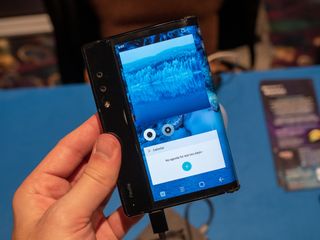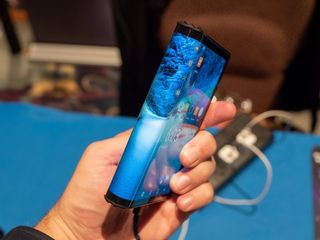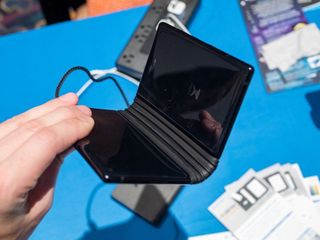Foldable phones are really here, and they're filled with unfortunate compromises

When it comes to foldable phones, all eyes are on Samsung right now. It's easily the leader in the world of foldable OLED technology, and has the general smartphone chops to build a complete experience that's likely to be the most polished of the segment this year. But all we've seen of the purported Galaxy X is a quick flash on stage at its unveiling — we haven't put our hands on one. The rest of the industry is marching on with its own foldable phone development, and some companies let us use what they're working on.
A company called Royole is showing off its foldable phone technology at CES 2019, and I commend them for jumping right in and letting anyone do whatever they want with this device. It isn't a dummy unit or locked in a demo loop, and you can spend as much time as you want with it to understand how foldable phones (or, at least this phone) work. But in being so transparent and open with people, we're starting to get a picture of the reality of the cutting edge of foldable phones: there are trade-offs to be had, and they're big.



Royole's FlexPai foldable phone is built around an OLED panel that measures in at 7.8 inches in a 4:3 aspect ratio. The total display comes in at 1920x1440, which is good enough for just over 300 ppi. Specs-wise it's completely normal: a Snapdragon processor, 6-8GB of RAM, 128-256GB of storage, and 16 + 20MP cameras. (Royole didn't disclose the battery size, but based on how quickly it charged I'm guessing it's quite small.) It has a fingerprint sensor sleekly embedded in the side. That's all boring, but it shows that we're to the point where you can have a crazy foldable phone form factor while having everything else inside the phone be modern and capable.
Yet, there are massive gaps in the experience that show this technology isn't ready for the mass market.

The FlexPai folds smoothly and has strong magnets to hold it in its folded state, which is really clever. But it has uneven bezels, much larger on one side, making the folded experience different depending on which side you hold. And at this point, the software gets tripped up trying to decide both which way you're holding the phone for rotation and which side of the phone you want to look at. At the same time, it has to turn off the touch response for the back and sides of the phone to keep accidental touches from throwing off the whole thing. It's slow, and clearly unfinished, but this is a problem all foldable phones will face and I'm skeptical that it can be addressed easily.

Then there's the general hardware problem. The FlexPai is basically two "normal" 16:9-ish phones connected along their long edge with a rubber accordion-style hinge. With the bezels and hinge mechanism in the middle, the phone is still really wide when folded. The screen bend is pretty darn tight, but not tight enough to keep the folded unit from being ungainly and thick. And when folded out flat, the hinge doesn't have the strength to "snap" the whole thing into place, leaving an ever-so-subtle bend in the screen or forcing you to disconcertingly pressure it flat by hyperextending it the wrong way. (And don't mind the USB cable you see in the photos — the battery unfortunately died while I was using it so I had to plug in for the photos.)
Finally, the screen. This is a problem every foldable phone, including the Galaxy X, is going to face: the screen is covered in plastic, not glass. Royole flips the script here to talk about the display being shatterproof, which it is, and rates its display at handling 200,000+ bends, which seems adequate. But plastic is in turn extremely scratch-prone compared to modern glass coverings. And at the same time, the thin and flexible plastic introduces some odd visual inconsistencies and waviness when the screen is flat — no doubt something that can be improved over time, but it's noticeable right now. And touching a thin plastic screen just doesn't feel as nice as touching Gorilla Glass.
Be an expert in 5 minutes
Get the latest news from Android Central, your trusted companion in the world of Android
(And then there's the Royole-specific problem of naming the phone "FlexPai" ... a re-brand is necessary.)






Foldable phone technology is surprisingly mature, but it still packs massive trade-offs.
For the near future, if we want to experience a foldable phone, we're going to have to accept the realities of the situation: there are going to be major trade-offs in the core smartphone experience. The fact that a company like Royole can make a fully functional foldable phone, with quirks but no deal-breaking issues, is a testament to how far along this technology is. But it's lacking an incredible amount of polish that's going to be required for these products to actually sell and make sense in the general smartphone market.
Whether it's a small company like Royole or a behemoth like Samsung that gets to market first, we're in for a bumpy ride of navigating the introduction of foldable phones with all of their shortcomings and issues.
Andrew was an Executive Editor, U.S. at Android Central between 2012 and 2020.
